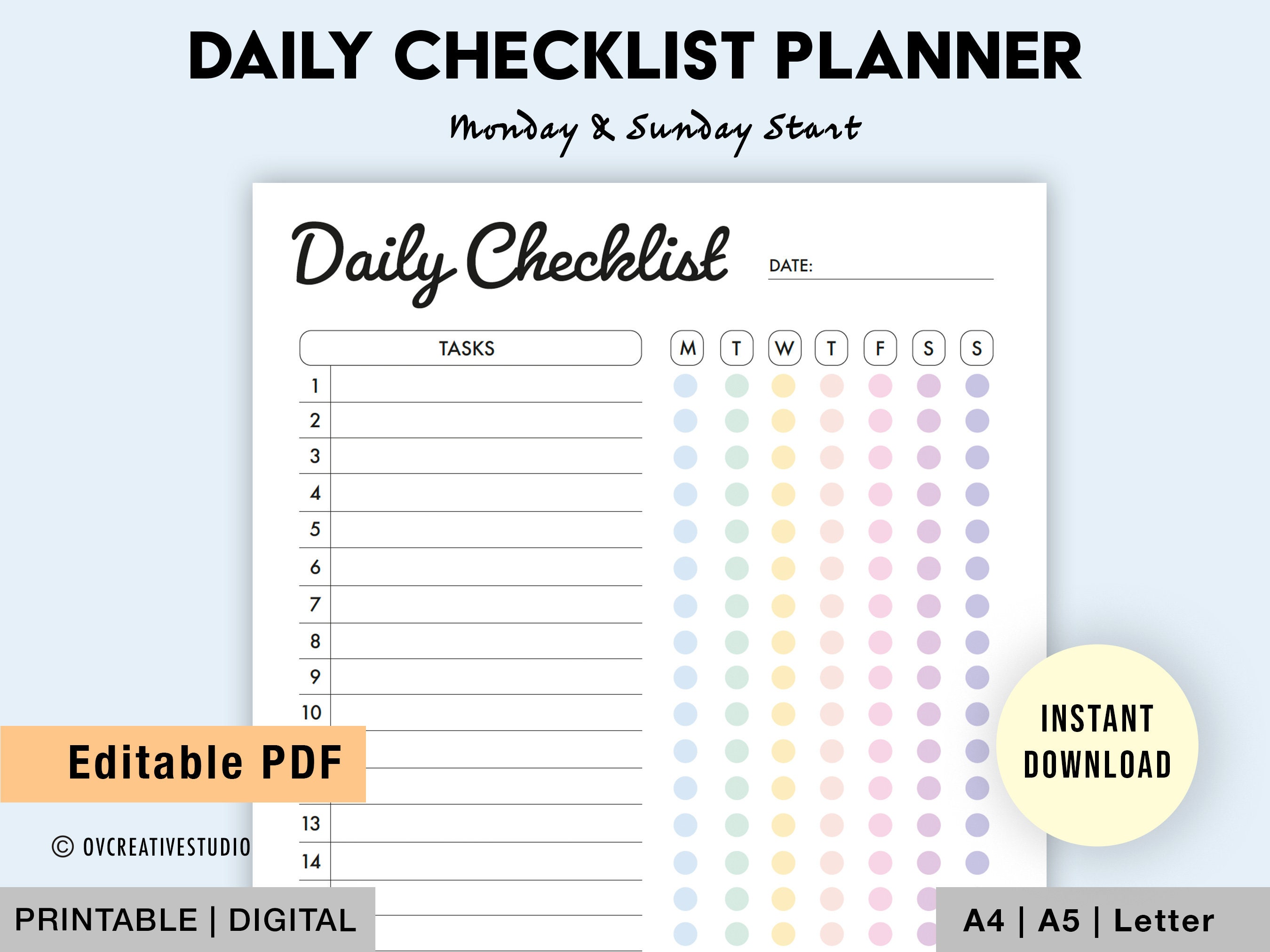
Absolutely! Here’s a comprehensive article about daily investing checklists, designed to resonate with a broad audience and offer practical, actionable advice.
The Investor’s Daily Ritual: Your Printable Checklist for Financial Success
Introduction
In the world of investing, consistency is often the unsung hero. While grand strategies and bold moves capture headlines, the daily habits and routines of successful investors quietly compound into significant long-term gains. This is where the power of a daily investing checklist comes into play.
Think of it as your financial compass, guiding you through the complexities of the market and keeping you aligned with your investment goals. A well-designed checklist isn’t just a to-do list; it’s a tool that fosters discipline, reduces emotional decision-making, and ultimately, increases your chances of achieving financial freedom.
This article will explore the concept of a daily investing checklist, its benefits, essential components, and how to create a personalized, printable version that fits your unique investment style and objectives.
Why a Daily Investing Checklist Matters
Investing can be a whirlwind of information, news cycles, and market fluctuations. Without a structured approach, it’s easy to get swept away by emotions, make impulsive decisions, and lose sight of your long-term goals. A daily investing checklist acts as an anchor, providing several key benefits:
-
Discipline and Consistency: Investing isn’t a sprint; it’s a marathon. A daily checklist helps you maintain consistent habits, such as reviewing your portfolio, staying informed, and making small, incremental improvements over time.
-
Reduced Emotional Decision-Making: Fear and greed are the enemies of rational investing. A checklist encourages you to stick to your predetermined strategy and avoid making impulsive decisions based on short-term market swings.
-
Improved Focus and Clarity: The financial world can be overwhelming. A checklist helps you prioritize your tasks and focus on the most important aspects of your investment strategy, filtering out the noise and distractions.
-
Enhanced Knowledge and Learning: By incorporating research and analysis into your daily routine, a checklist encourages continuous learning and improvement, helping you become a more informed and confident investor.
-
Accountability and Progress Tracking: A checklist provides a tangible record of your daily activities, allowing you to track your progress, identify areas for improvement, and stay accountable to your investment goals.
Essential Components of a Daily Investing Checklist
A comprehensive daily investing checklist should cover a range of activities, from market monitoring to portfolio review and personal development. Here are some essential components to consider:
-
Market Monitoring:
- Review Key Market Indices: Start your day by checking the performance of major market indices like the S&P 500, Dow Jones Industrial Average, and Nasdaq Composite. This will give you a broad overview of the market sentiment.
- Check Economic News: Stay informed about important economic releases, such as GDP growth, inflation rates, and unemployment figures. These indicators can provide insights into the overall health of the economy and potential impacts on your investments.
- Monitor Industry-Specific News: If you invest in specific sectors or industries, keep an eye on relevant news and developments that could affect your holdings.
-
Portfolio Review:
- Review Asset Allocation: Ensure your portfolio’s asset allocation (e.g., stocks, bonds, real estate) still aligns with your risk tolerance and investment goals. Rebalance if necessary.
- Check Portfolio Performance: Track the performance of your individual investments and your overall portfolio. Compare your returns to relevant benchmarks to assess your progress.
- Identify Potential Rebalancing Opportunities: Look for opportunities to rebalance your portfolio by selling overperforming assets and buying underperforming ones to maintain your desired asset allocation.
-
Research and Analysis:
- Read Financial News and Analysis: Stay informed about market trends, investment strategies, and company-specific news by reading reputable financial publications and analysis reports.
- Research Potential New Investments: If you’re considering adding new assets to your portfolio, conduct thorough research on the companies or investment vehicles you’re interested in.
- Analyze Company Financial Statements: If you invest in individual stocks, review the company’s financial statements (e.g., income statement, balance sheet, cash flow statement) to assess its financial health and performance.
-
Personal Development:
- Read Investment Books or Articles: Expand your knowledge and skills by reading books, articles, or blogs on investing, personal finance, and related topics.
- Listen to Financial Podcasts or Webinars: Stay up-to-date on market trends and investment strategies by listening to financial podcasts or attending webinars.
- Network with Other Investors: Connect with other investors to share ideas, learn from their experiences, and stay motivated.
-
Administrative Tasks:
- Review Account Statements: Regularly review your brokerage and retirement account statements to ensure accuracy and identify any potential errors or fraudulent activity.
- Update Financial Goals: Periodically review your financial goals and adjust your investment strategy as needed to ensure you’re on track to achieve them.
- Track Expenses and Savings: Monitor your expenses and savings to ensure you’re living within your means and contributing enough to your investment accounts.
Creating Your Personalized, Printable Investing Checklist
The beauty of a daily investing checklist is that it can be customized to fit your unique investment style, goals, and available time. Here’s a step-by-step guide to creating your own printable checklist:
-
Identify Your Investment Goals: What are you trying to achieve with your investments? Are you saving for retirement, a down payment on a house, or another specific goal? Your checklist should align with your goals.
-
Assess Your Risk Tolerance: How comfortable are you with the possibility of losing money on your investments? Your risk tolerance will influence your asset allocation and the types of investments you choose.
-
Determine Your Time Commitment: How much time are you willing to dedicate to investing each day? Be realistic about your available time and prioritize the most important tasks.
-
Choose a Format: You can create your checklist using a word processor, spreadsheet program, or a dedicated checklist app. Choose a format that’s easy to use and customize.
-
List Your Essential Tasks: Based on your goals, risk tolerance, and time commitment, list the tasks you want to include in your daily checklist. Use the components outlined above as a starting point.
-
Prioritize Your Tasks: Rank your tasks in order of importance and focus on completing the most critical ones first.
-
Make It Printable: Format your checklist so that it’s easy to print and use on a daily basis. Use clear headings, bullet points, and checkboxes to make it visually appealing and user-friendly.
-
Test and Refine: Once you’ve created your checklist, test it out for a week or two and make any necessary adjustments. Your checklist should be a living document that evolves as your investment needs and goals change.
Tips for Using Your Daily Investing Checklist Effectively
- Be Consistent: The key to success with a daily investing checklist is consistency. Make it a habit to review and complete your checklist every day, even when you’re busy or the market is volatile.
- Be Flexible: While consistency is important, don’t be afraid to adjust your checklist as needed. If your investment goals or circumstances change, update your checklist accordingly.
- Track Your Progress: Use your checklist to track your progress and identify areas for improvement. Are you consistently skipping certain tasks? Are you achieving your investment goals?
- Stay Motivated: Investing can be a long and challenging journey. Stay motivated by celebrating your successes, learning from your mistakes, and staying focused on your long-term goals.
Conclusion
A daily investing checklist is a powerful tool that can help you achieve your financial goals by fostering discipline, reducing emotional decision-making, and enhancing your knowledge and understanding of the market. By creating a personalized, printable checklist and using it consistently, you can take control of your financial future and build a solid foundation for long-term success. Remember, investing is a marathon, not a sprint, and a well-designed checklist can help you stay on track and reach the finish line.



